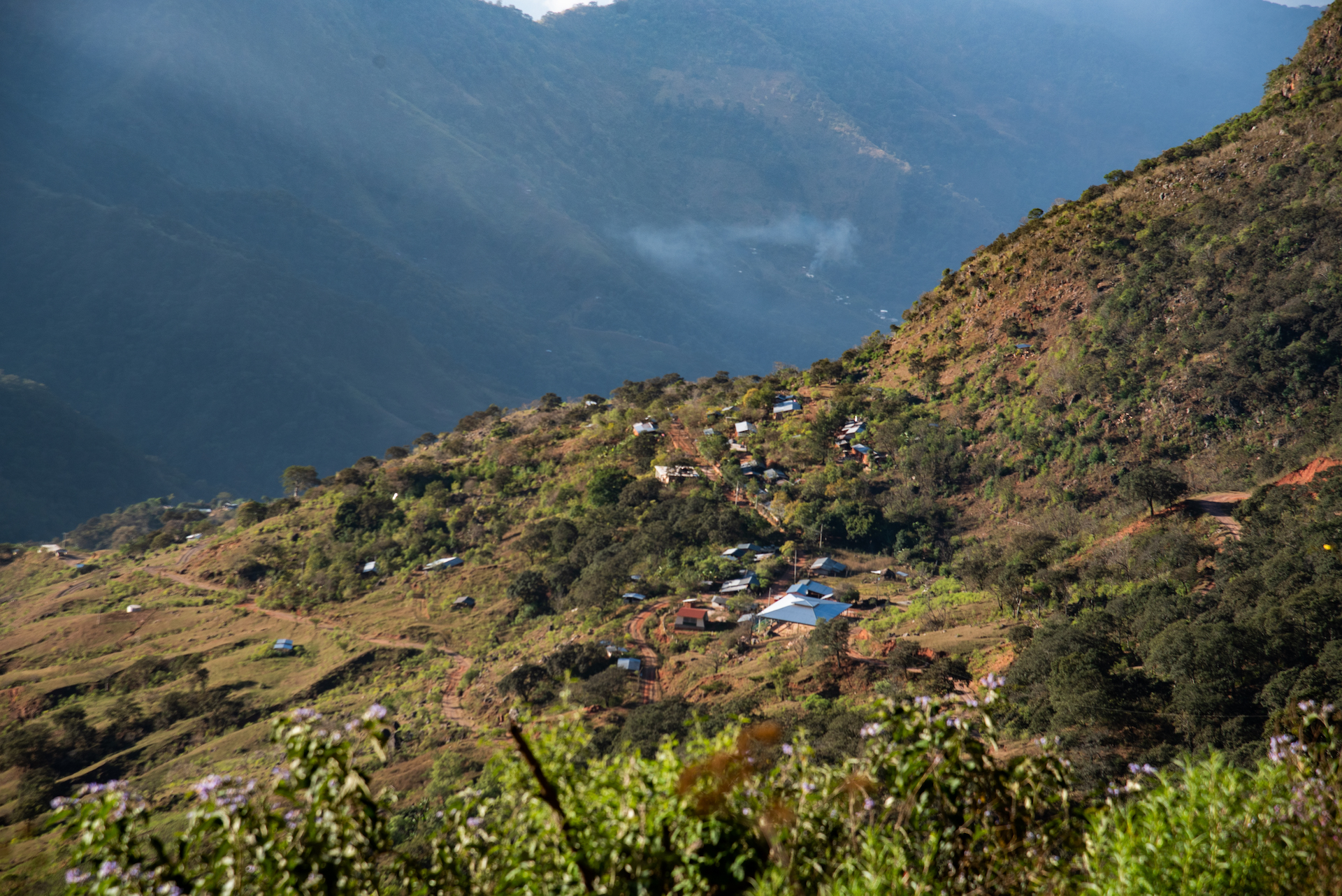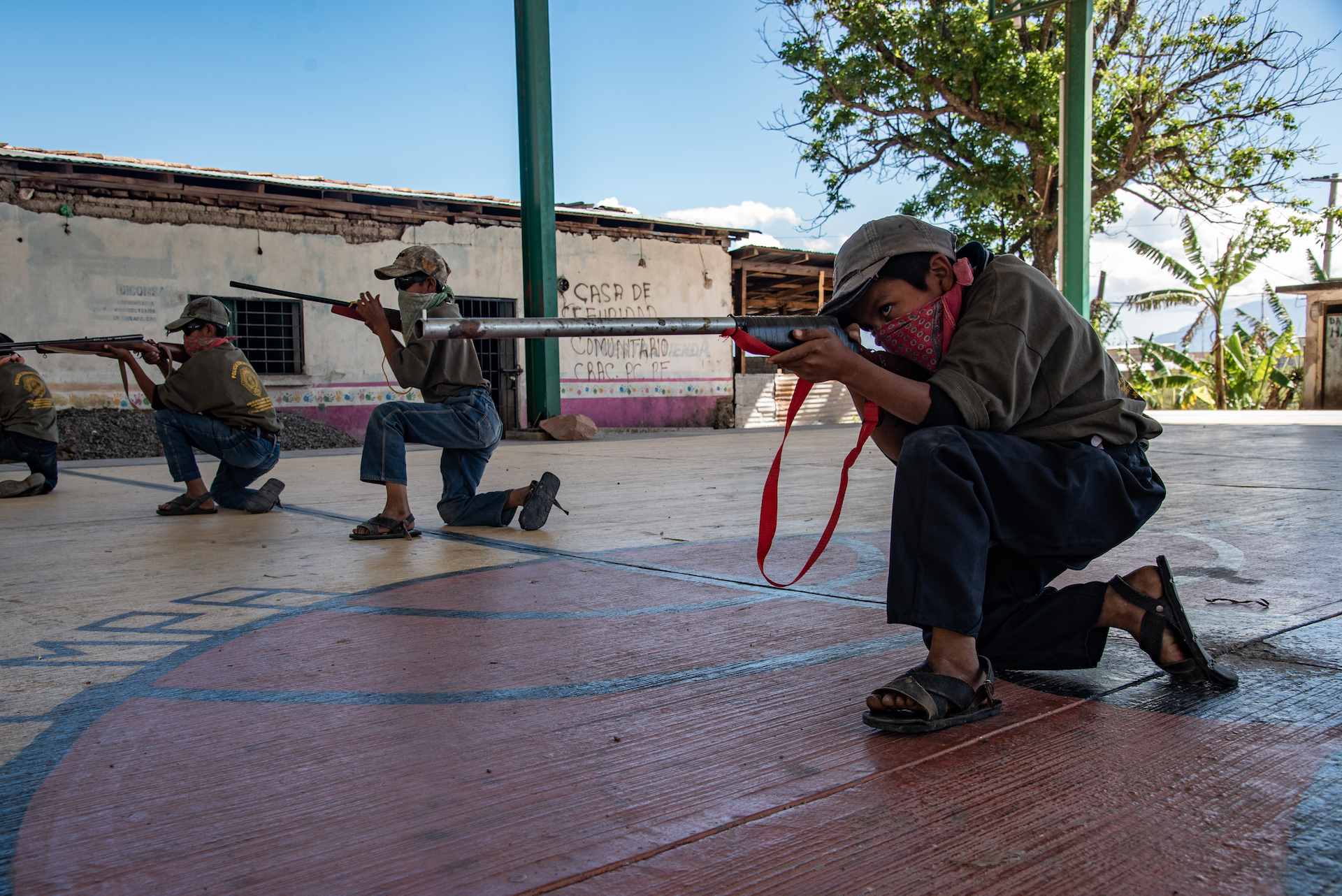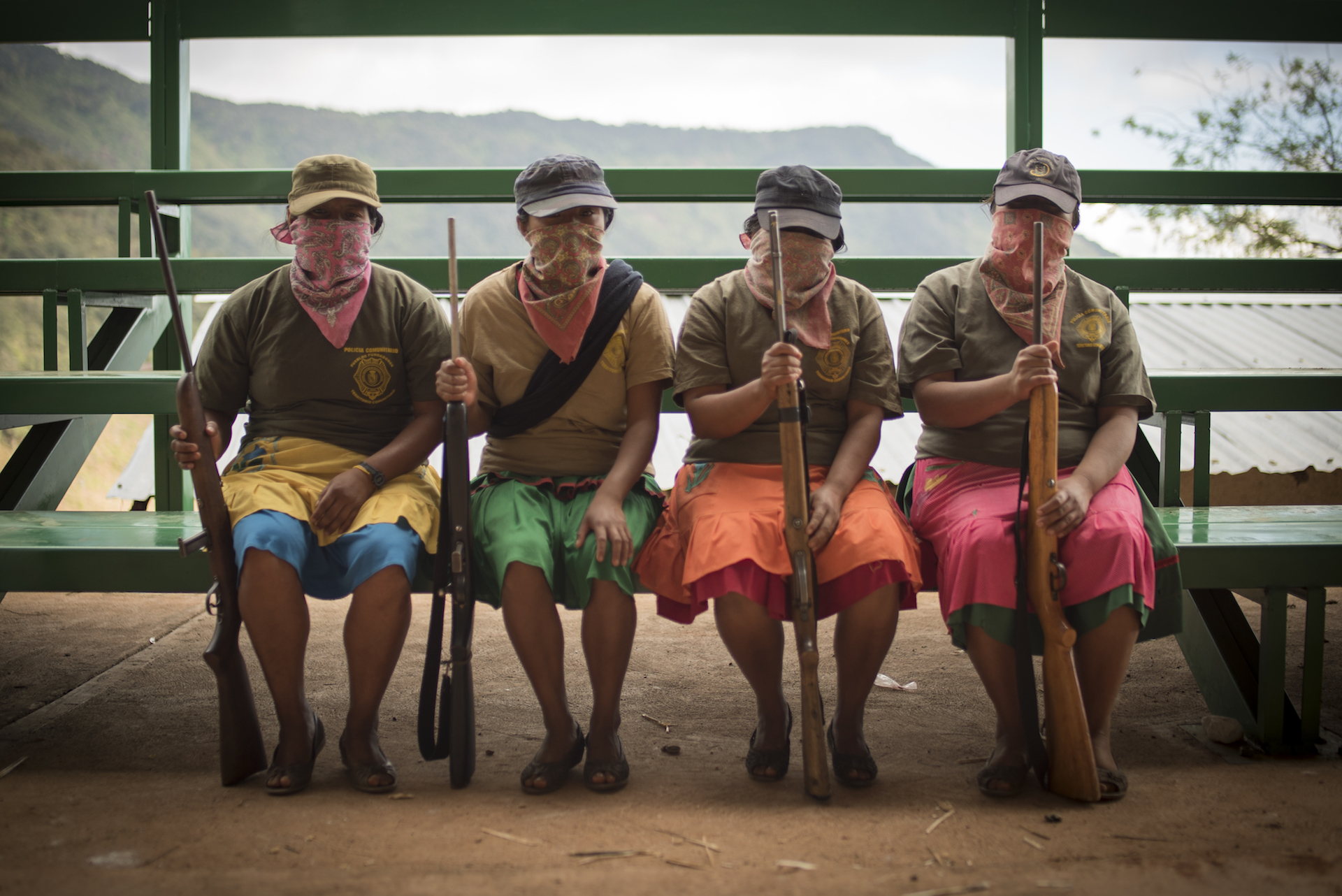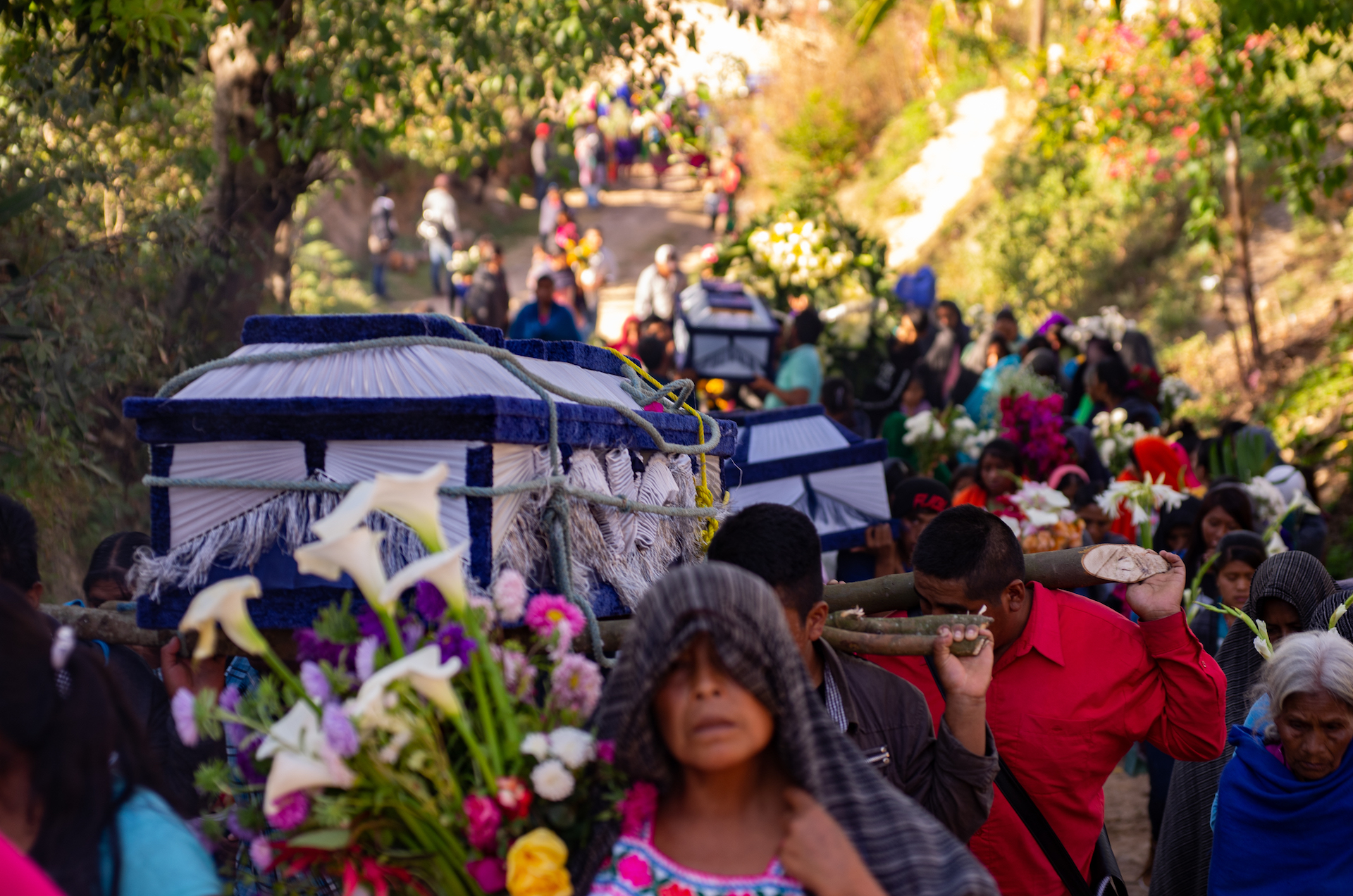Meet the Children Being Armed to Defend a Mexican Village From Drug Cartels
Credit to Author: Emily Green| Date: Fri, 07 Feb 2020 18:26:13 +0000
AYAHUALTEMPA, Mexico — The boys sling .22-caliber rifles over their shoulders, standing erect, their faces covered with bandanas and caps to shield their identities. Their leader, Luis, a scrawny figure with warm eyes, calls out commands. “Position four!” he yells in a high-pitched voice. In unison, the dozen recruits fall to the floor of the basketball court, belly-down, aiming their guns straight ahead.
Luis is 13 years old.
Luis and his barely adolescent friends are the latest enlistees in a self-defense group in Mexico’s southwestern state of Guerrero, which sits at the heart of Mexico’s heroin trade and has been wracked by violence in recent years. The citizen militia is training the boys, some as young as 6, to serve as the last line of defense should a cartel strike the community, as it has others.
The militia, known as CRAC-PF, emerged in 2014 in place of local police who were considered corrupt, and stretched-thin federal and state security forces. Amid a wave of violence and targeted attacks by a local drug cartel, they’ve taken the drastic step of training children to use guns.
“We are preparing the children because if they lose their parents, who is going to defend them? What’s clear is that the government is not going to defend us and much less the human rights advocates who criticize us,” said Bernardino Sánchez Luna, who founded the group.
Government officials and human rights groups accuse the militia of exploitation. Even in a country accustomed to a steady drumbeat of violence, the images of the children in military-style exercises published by local media earlier this year have pierced the public consciousness, drawn comparisons to child soldiers, and raised questions about whether this will become a new norm.
President Andrés Manuel López Obrador said the militia should be “ashamed” for arming the boys. “Training children to use weapons and then filming them is an abuse,” he said.
But the boys’ training appears elementary at best, somewhere between guerrilla warfare and Boy Scouts, as they practice the same positions on repeat. The boys’ parents say it’s an act of desperation by a community that’s trapped by violence on all sides. It’s also a gambit to get the attention of government officials who they say have abandoned them.
Nestled in the foothills of the Sierra Madre del Sur mountain range, Ayahualtempa is one of 16 indigenous communities protected by the militia. The communities are isolated hamlets with limited cell service, accessible only by a winding two-lane highway known as the “corridor of death,” as rival gangs fought for control of the drug route and tussled with civilian militias.

The violence detonated last year. A growing number of people from Ayahualtempa were murdered when they ventured outside the village: one man shot in his car, another kidnapped, a boy shot dead in broad daylight. Luis’ uncle was also killed. “They hid it from me, but I learned he had been found dismembered,” Luis said.
“They hid it from me, but I learned he had been found dismembered.”
Ayahualtempa had never received much government support, but now it was a target as the local cartel tried to take control. The number of murders in the six miles around the village more than doubled in 2019 from a year earlier, said Chris Kyle, a professor at the University of Alabama at Birmingham who studies violence in the region.
The community went on virtual lockdown. Kids stopped going to school. The women halted their weekly trips to the nearby city to do their shopping and sell their beans and squash. The men ventured out only in convoys with a dozen armed companions for fear of being ambushed.
“If we leave town, we might get kidnapped,” Luis said.
In April, members of the civilian militia took around a dozen boys on an eight-day retreat into the mountains. Luis went with his older brother, 15. He listed off the things they learned: “attacking armored vehicles, fighting off ambushes, rescuing allies.”
“Drill commands are for parades and celebrations, but shooting positions are for real enemy encounters,” he said.
Boys 12 and older were given guns, a mix of 22-caliber rifles and 20-gauge shotguns. The younger boys practiced with sticks and toys, in preparation for the day when they can carry guns.

Luis was named a leader of the group because he didn’t miss a day of training. But at school, his teacher told him he was at risk of being expelled because he had skipped so many days. Luis loved school — math class in particular — but his mom was terrified every time he went.
While just a 30-minute walk from the village, the middle school is in territory controlled by the drug cartel. Parents were terrified. By summer, Luis and his brother and sister stopped attending school because of the violence, as did most of the older kids in the community.
“Of course, it makes me scared that they walk around with guns.”
“More than anything, I wish they studied. If things were peaceful, then they could study and make something of themselves,” said Luis’ mother, Dominga, who asked to withhold her last name to protect her son. She runs the house and takes care of the family cows. “Of course, it makes me scared that they walk around with guns. But it’s so they can defend themselves.”
The escalation in violence comes amid a larger security crisis in Mexico, with 2019 registering the highest number of murders on record. López Obrador has rejected a strategy of head-on confrontation with the cartels, saying it leads to more violence.
In Guerrero, Los Ardillos cartel, or “The Squirrels,” is sowing terror.
Long associated with poppy production and heroin distribution, it has used kidnappings, murders, and extortion to vanquish critics and exert control over the region. In 2015, hundreds of armed men reportedly from Los Ardillos entered the city of Chilapa searching for members of a rival cartel. At least 15 people disappeared.

The cartel is run by three brothers; a fourth brother is a former politician who served as president of the Congress in Guerrero.
Luis Hernández Navarro, a Mexican journalist who has studied the region, said the cartel is seeking to assert absolute control, and that indigenous communities are some of the last holdouts. “They have done everything possible to kick the indigenous communities out of their territories,” he said. “The idea is to have a free corridor to transport drugs.”
In January 2019, Los Ardillos tried to enter one of the 16 villages protected by the militia. A firefight ensued, and at least 10 cartel members died, according to community members and press accounts. Soon after, indigenous women from the hamlet began training with guns so they could also fight in case they were attacked again.
Los Ardillos have made it clear they will go after anyone associated with the civilian militia, and this year they appeared to make good on that promise.
In January, 10 musicians from an indigenous village were ambushed as they returned home from playing a concert. The bodies of the men, between the ages of 15 and 42, were found in two vans, their bodies burned beyond recognition.
Government officials blamed Los Ardillos for the attack and described it as “an act of vengeance,” referencing the shoot-out a year earlier.
The murders prompted the militia to hold a march, where they paraded the boys with guns before local news outlets. It was an escalation of a strategy they had utilized months earlier when they uploaded videos to social media of children training with sticks. The Mexican news giant Televisa broadcast images from the march, and the story landed on the front pages of newspapers around the country.

Government officials and human rights groups condemned the group, accusing it of exploitation.
“It doesn’t matter if the recruiting is being done by criminal groups, the military, or indigenous self-defense groups; it’s a crime,” said Juan Martín Pérez García, executive director of REDIM, a collective of children’s advocacy groups in Mexico.
The display of armed children is disputed even within the militia, with accusations of rogue actors using the kids as propaganda.
But the strategy has spurred action. The government deployed military forces to help shore up security, and the governor met with community leaders to discuss their demands.
“Now that we show off the children, the governor is coming to our community and meeting with us. But if we hadn’t done that, the governor would never have come,” said Sánchez Luna, the militia’s founder.
Tensions between the indigenous communities and the government extend back to the 1990s, said Abel Barrera Hernández, a Mexican anthropologist and director of the Center for Human Rights of the Mountain of Tlachinollan in Guerrero. The communities refused to participate in a nationwide land reform program, because they viewed land as community-owned instead of private property.
That fueled agrarian conflicts and long-standing feuds that have contributed to the violence today. Barrera said the government ignored the conflict and left the indigenous communities to fend for themselves.
“No one takes notice when the children are illiterate and malnourished. No one cares until they see children with guns.”
“No one takes notice when the children are illiterate and malnourished. No one cares until they see children with guns,” he said. “This is a strategy, a cry of despair before the inaction, indolence, and racist attitudes of the government authorities. The innocence has been snatched from these children and they have to wake up in this nightmare.”
The line between innocence and adulthood is increasingly blurred. Between exercises with the guns, the boys hang around the basketball court and play with yoyos, killing time before they go to the fields to take care of their goats and cows. The 15-year-old boys have started going on night patrols with the other men in the community.
Luis has yet to shoot a gun at a person, and he said if his village is attacked, he plans to stay back at home to defend his mom and sister. “They taught me that weapons aren’t to be used to rob people. It’s only to protect ourselves if the criminal group shows up.”
He said he misses going to school, especially his math classes. He was learning long division. He wanted to become a teacher or a doctor — he’s not sure which, perhaps both. Those dreams are gone. “If it weren’t for the crime, I would continue,” he said.
Luis rarely leaves his house without his gun, wary of being kidnapped or killed at any second. “I like to take care of my goats. And to play basketball,” he said. “I still feel like a kid, even though I’m carrying a weapon.”
Cover: Luis, 13, has become a leader of the junior militia. He rarely leaves the house without his 20-gauge shotgun. (Jika Gonzalez/VICE News)
This article originally appeared on VICE US.